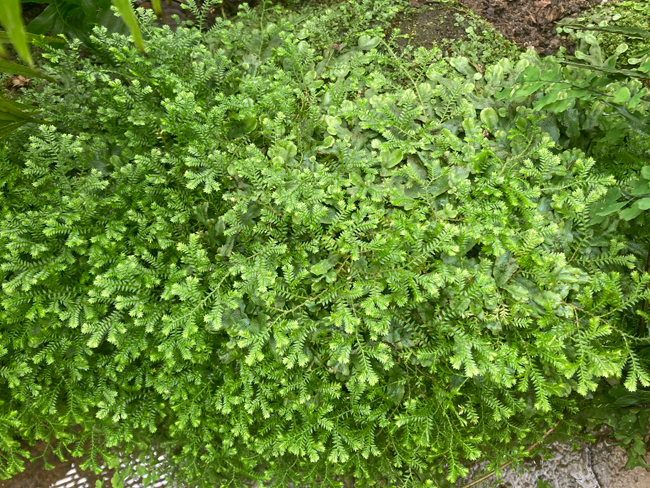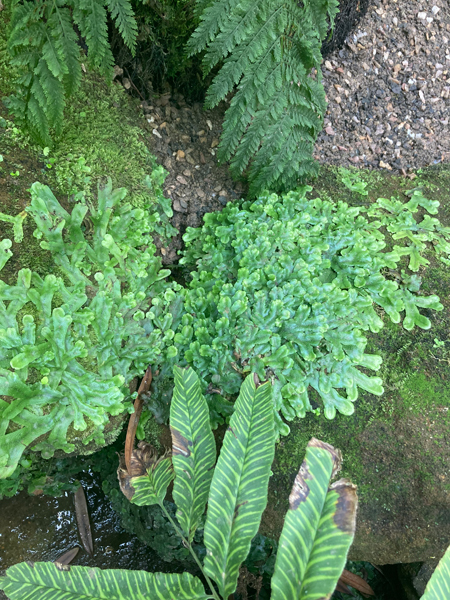A visit to the beautiful Cambridge University Botanic Gardens permitted Everything Dinosaur team members to photograph examples of early plants. Visitors can pick up a free booklet at the entrance that provides details of a prehistoric plant trail. It introduces a selection of plants that explains the evolution of the Kingdom Plantae. It starts with freshwater green algae and tours the University’s collection highlighting key points in plant evolution using selected specimens.
Several of the plants on the trail can be found in the greenhouses. For example, the picture below shows examples of plants similar to some of the very first plants to colonise the land. Snakeskin liverwort is growing alongside a spiky hair moss (we think). Liverworts are spore-producing, rather than seed-producing, and they are all without flowers. Like mosses and hornworts, they are bryophytes. Liverworts come in two growth forms, with both thallose species (undifferentiated body) and leafy species. The latter having leaves on stems, just like mosses. Hence the confusion below as to whether the spiky stems in the picture are a moss or a liverwort.

Examples of plants similar to some of the very early plants to colonise land can still be found today. The photograph shows the scale-like Snakeskin liverwort (Conocephalum conicum) growing together with a spiky Hair moss (Polytrichum commune) – we think. However, the spiky plant could be an example of a leafy liverwort. Picture credit: Everything Dinosaur.
Picture credit: Everything Dinosaur
Taking Photographs of Examples of Early Plants
The trail explores the evolution of plants. Unlike animals that can be difficult to photograph, the plants were most obliging. Not having a subject moving around makes taking a photograph far easier. The Botanic Gardens were wonderful. It is a great place to visit if you are in Cambridge, making a change from the hustle and bustle of the universities and the town centre. It has links with Darwin too. The current gardens were inspired by John Stevens Henslow. He was Professor of Botany at Cambridge from 1825 to 1861. His ideas about variation helped shape the views of his famous protégé Charles Darwin.

Plants have a long and complex evolutionary history, originating in freshwater pools and streams around 470 million years ago. Many of the early land plants were restricted to damp locations such as the edge of pools. The photograph shows a colony of liverwort growing over a moss-covered rock. Two types of fern can also be seen in the photograph. Picture credit: Everything Dinosaur.
Picture credit: Everything Dinosaur
The second photograph shows a thallus liverwort growing across a rock. Another example of a bryophyte can be seen in the photograph. It is the moss that is also growing on the rock. Liverworts, hornworts and mosses prefer to grow in damp shady places. Two examples of ferns, another type of ancient plant are in the image too. Ferns are thought to have originated around 36o million years ago.
Commenting on the visit to Cambridge University Botanic Gardens, Mike from Everything Dinosaur stated:
“The Gardens are beautiful. There is so much to see, and a special visitor trail has been set up permitting visitors to learn more about the long evolutionary history of plants. Furthermore, the trail supports the University’s first year Natural Sciences lecture series in plant evolution.”
The Everything Dinosaur website: Prehistoric Animal Models and Toys.


Leave A Comment